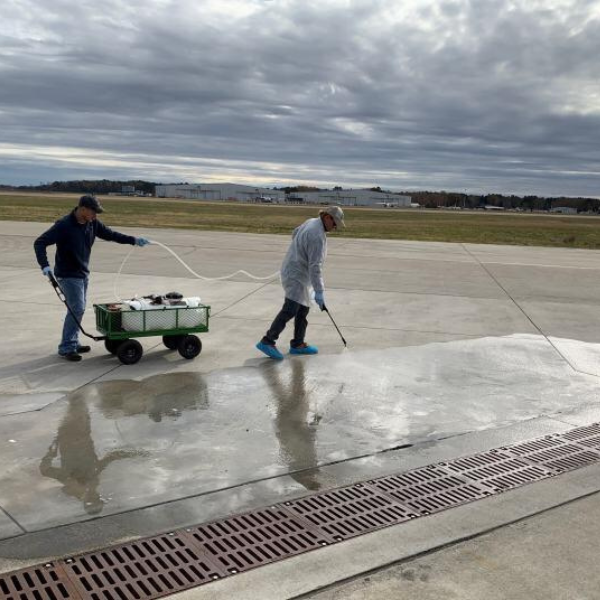Release Date: March 17, 2022
If large-scale contamination with a biological agent took place near a major coastal city, it would impact how the U.S. Coast Guard (USCG) carries out its lifesaving, environmental and interdiction missions—not to mention the toll on surrounding communities. To help the agency better prepare, respond, and recover, the Science and Technology Directorate (S&T) and the U.S. Environmental Protection Agency’s (EPA) Homeland Security Research Program joined forces for a Stormwater Tracer Study at Coast Guard Base Elizabeth City in North Carolina. The study tracks the movement of ‘pathogen’ spores, which may be carried downstream by runoff after rainstorms, thereby complicating mitigation and decontamination measures. Through sampling and modeling, spores transported by stormwater runoff can be predicted and verified to assist in the effective cleanup of a site.
“The Stormwater Tracer Study helps us have a better understanding of how rain transports spores and enhances emergency response by increasing the effectiveness and timeliness of sampling and decontamination activities for the impacted stormwater,” said Dana Tulis, director of Emergency Management at USCG headquarters.
The study is part of a multi-year project called Analysis for Coastal Operational Resiliency (AnCOR), which kicked off in 2018 and included several joint field tests. Together, S&T, EPA, and USCG have been working to identify the best and safest methods to decontaminate bases, stations, and vessels, should they be affected by large-scale contamination from a pathogen like the anthrax-causing bacterium.
The first major AnCOR field test took place in early 2020 at the University of Florida, during which the agencies decontaminated a Coast Guard boat ‘contaminated’ with non-pathogenic spores. In 2021, the team initiated the new Stormwater Tracer Study, which allowed them to gauge how rain transports the benign spores meant to simulate what would occur in the environment. Knowing in advance how pathogens may make their way towards USCG installations and surrounding communities allows responders to trace the spores more quickly after rainstorms and develop decontamination strategies.
“S&T funded the tracer studies to support EPA in building a general hydrodynamic model for USCG. The model will help select outdoor areas to sample for biological agents like Bacillus anthracis following rainfall events,” said Dr. Don Bansleben, S&T program manager for Chemical and Biological Detection. “Such information maximizes the probability of finding spores that may be transported or concentrated during a rainfall to determine if concrete, asphalt, and grassy areas continue to represent a threat to health.”
To read more about Identifying Solutions for a Quick Return to Normal after Pathogenic Contamination & Tracer Studies Will Help Develop Prediction Maps of Spore Spread, click the button below.

